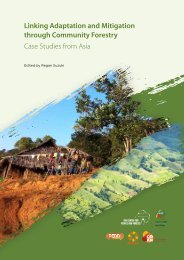Desktop Study on - Regional Climate Change Adaptation ...
Desktop Study on - Regional Climate Change Adaptation ...
Desktop Study on - Regional Climate Change Adaptation ...
You also want an ePaper? Increase the reach of your titles
YUMPU automatically turns print PDFs into web optimized ePapers that Google loves.
Assessment of Capacity Gaps and Needs of South East Asia Countries<br />
in Addressing Impacts, Vulnerability and Adaptati<strong>on</strong> to <strong>Climate</strong> Variability and <strong>Climate</strong> <strong>Change</strong><br />
Disaster Risk Management<br />
In additi<strong>on</strong>, Viet Nam has a l<strong>on</strong>gstanding instituti<strong>on</strong>al<br />
resp<strong>on</strong>se system for natural disasters, which is<br />
coordinated mainly by the Central Committee for<br />
Flood and Storm C<strong>on</strong>trol (CCFSC), chaired by the<br />
MARD. The CCFSC was created in 1955 to coordinate<br />
disaster risk management activities; other relevant<br />
ministries are also members such as the Department<br />
of Floods and Storm C<strong>on</strong>trol and Dyke Management,<br />
the Disaster Management Centre, the Hydrometeorological<br />
Service, and the Viet Nam Red Cross<br />
(VNRC) (which is working from nati<strong>on</strong>al to commune<br />
level <strong>on</strong> awareness raising, disaster preparedness,<br />
resp<strong>on</strong>se and preventi<strong>on</strong>). The CCFSC is resp<strong>on</strong>sible<br />
of data and record flood and storm events, as well as<br />
send out official warnings and coordinating disaster<br />
resp<strong>on</strong>se and mitigati<strong>on</strong> measures. Local authorities<br />
and each sector ministry also have committees<br />
for flood and storm c<strong>on</strong>trol (CFSCs), which are<br />
important for sharing informati<strong>on</strong> <strong>on</strong> damage and<br />
needs, communicating early warning informati<strong>on</strong>,<br />
damage assessments, coordinating rescue during<br />
floods, and protecting dykes and other infrastructure<br />
(Chaudhry and Ruysschaert, 2007). These crosssectoral<br />
committees are presently expected to<br />
produce annual disaster preparedness plans.<br />
The Government, NGOs and d<strong>on</strong>ors compose the<br />
Natural Disaster Mitigati<strong>on</strong> Partnership (NDM-P)<br />
to promote dialogue and comm<strong>on</strong> ways of working<br />
for disaster reducti<strong>on</strong> rather than disaster resp<strong>on</strong>se.<br />
The MARD was assigned by the Government<br />
to lead the initiative supported by the Royal<br />
Netherlands Embassy (RNE) and the United Nati<strong>on</strong>s<br />
Development Programme (UNDP); also it is in charge<br />
of coordinating the implementati<strong>on</strong> of the Sec<strong>on</strong>d<br />
Nati<strong>on</strong>al Strategy and Acti<strong>on</strong> Plan for Disaster<br />
Mitigati<strong>on</strong> and Management (discussed below).<br />
Nati<strong>on</strong>al Strategy for Natural<br />
Disaster Preventi<strong>on</strong>, Resp<strong>on</strong>se and<br />
Mitigati<strong>on</strong><br />
Viet Nam’s policy framework for disaster<br />
management is set in the Nati<strong>on</strong>al Strategy and Acti<strong>on</strong><br />
Plan for Disaster Mitigati<strong>on</strong> and Management 2001-<br />
2020, in which the MARD is the standing agency,<br />
and the Central Committee for Flood and Storm<br />
C<strong>on</strong>trol, will both preside the implementati<strong>on</strong> for<br />
the strategy to 2020 and the Government is the <strong>on</strong>e<br />
that has to ensure enough resources, investment and<br />
mobilizati<strong>on</strong> of society. The nati<strong>on</strong>al strategy states<br />
that it must be implemented in synchr<strong>on</strong>ous, periodbase<br />
and priorities-based manners, resp<strong>on</strong>sive<br />
to both intermediate and l<strong>on</strong>g term purposes and<br />
following the “four-<strong>on</strong>-the-spot” principles for<br />
resp<strong>on</strong>se (command, man-power, materials and<br />
logistics).<br />
The Nati<strong>on</strong>al Strategy’s specific objectives<br />
are: enhancing disaster forecasting, improve<br />
development planning (integrating strategy and<br />
plans of disaster risk management) and building<br />
codes, trainee and strength human resource (staff)<br />
for disaster preventi<strong>on</strong> and increased public<br />
awareness, complete relocati<strong>on</strong> of people living<br />
in disaster vulnerable areas, improve resp<strong>on</strong>se to<br />
emergency situati<strong>on</strong>s (search and rescue capacity),<br />
ensure nati<strong>on</strong>al security and defence in coastal areas<br />
(improved sea dykes and embankments), improved<br />
safety of reservoirs, completi<strong>on</strong> of shelters for<br />
shipping, improved communicati<strong>on</strong>s system for<br />
fishing boats. It also proposes to formulate a law,<br />
c<strong>on</strong>solidate organizati<strong>on</strong>al structures and ensure<br />
there are sufficient budgetary resources for disaster<br />
risk management.<br />
The strategy describes in detail the general<br />
resp<strong>on</strong>sibilities and soluti<strong>on</strong>s for developing the<br />
specific objectives as well as the natural disaster<br />
preventi<strong>on</strong>, resp<strong>on</strong>se and mitigati<strong>on</strong> resp<strong>on</strong>sibilities<br />
and soluti<strong>on</strong>s for each regi<strong>on</strong> (Red River Delta and<br />
North Central, Central Coast, Eastern South and<br />
Islands, Mek<strong>on</strong>g River Delta, Mountainous areas and<br />
Central Highlands, and Sea areas).<br />
The nati<strong>on</strong>al strategy provides a list of programs<br />
grouped according to the objectives and<br />
resp<strong>on</strong>sibilities and ordered by priority. Am<strong>on</strong>g<br />
the priorities can be found: complete the system<br />
of legal documents, especially Natural Disaster<br />
Preventi<strong>on</strong> Resp<strong>on</strong>se and Mitigati<strong>on</strong> Law; strengthen<br />
organizati<strong>on</strong>al mechanism giving priority to the<br />
steering mechanism for natural disaster preventi<strong>on</strong>,<br />
resp<strong>on</strong>se and mitigati<strong>on</strong> at all levels; am<strong>on</strong>g the n<strong>on</strong>structural<br />
measures, there are several programs<br />
involved, the program of establishing and reviewing<br />
plans (here the priority is given to create a z<strong>on</strong>ing<br />
map of flash-flood risk), the program of improving<br />
the community awareness (which starts with<br />
the inclusi<strong>on</strong> of knowledge related to disasters<br />
at the sec<strong>on</strong>dary school), program of planting<br />
and preserving protective forest (starting with<br />
upstream forest) and program of enhancing disaster<br />
management and science and technology applicati<strong>on</strong><br />
capacity; and finally, the structural measures, starts<br />
with the program to review, upgrade, and build<br />
structures for natural disaster preventi<strong>on</strong>, resp<strong>on</strong>se<br />
and mitigati<strong>on</strong> in line with the designed standards<br />
and natural disaster characteristics of each regi<strong>on</strong><br />
(and local).<br />
49

















